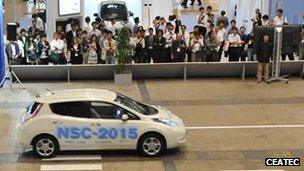Nissan car drives and parks itself at Ceatec
- Published

An electric car that is able to park itself and come to the driver when "called" has been unveiled at the Ceatec 2012 show in Tokyo.
Nissan's NSC-2015 is only a prototype, but its name suggests the carmaker aims to have it on the market by 2015.
Many car companies have been working on autonomous technology, with a number of driverless cars unveiled in recent months.
But one analyst warned that the mass use of such cars was a long way off.
The NSC-2015 is a modified version of Nissan's Leaf model.
It relies on sensors, cameras, computers and 4G communication technology for wireless links to navigate, and robotics to turn the steering wheel, change gears and brake.
When demonstrated at Ceatec, the car drove itself at about 3mph (5km/h) in a straight line forward and in reverse, and was able to turn.
It was shown that the car could recognise road markings and was able to stop at a crossing.
A Nissan representative also controlled the car from the outside, making it drive towards him as he pressed some buttons on his phone.
"After the driver exits the NSC-2015, it starts to park itself automatically, following the instructions given by smartphone," the company said.
"The vehicle looks for a vacant parking space while identifying its surroundings; once it detects an open parking space automated parking begins.
"The driver can also use smartphone commands to make the NSC-2015 vehicle leave the parking space and return to the place where he or she is.
"While parked, the car's security camera system automatically works with a camera installed in the vehicle. If the system detects suspicious behaviour, the driver is alerted automatically by a report to his or her smartphone."
However, Tooru Futami, engineering director at electronics engineering development division at Nissan, told Forbes that the car was not yet able to self-drive down the street or park itself in any space.
He said the demo version could only self-park in an area equipped with sensors and restricted to other robotic cars to avoid the risk of collision.
Showcasing technology
Several car manufacturers and other companies such as Google have recently demonstrated driverless vehicles and three US states - California, Nevada and Florida - even allow self-driving cars on their roads.
But one analyst told the BBC the mass use of such vehicles was still some way off.
"Self-driving cars is the way we're heading - it's the pinnacle of the convergence of a lot of technologies," said Paul Newton from IHS Automotive.
"You have ad hoc car-to-car networking which will alert cars of problems ahead, roadside transmissions to limit speed, controlled steering and braking - and all these technologies will eventually converge to a point where you can arrive at something that drives itself.
"But I think that market for driverless cars is limited at the moment in terms of consumer perception. People still have a fairly strong desire to control their car, and producing these vehicles is more showcasing what's possible than what's likely at the moment."
He added that it was more likely the driver would be able to actively operate the vehicle in some places, but once he or she got into a controlled urban environment, the vehicle would take over.
"You'll arrive in a town - and there will be a signal sent to your car not to exceed a maximum speed, and you won't be able to, and distance to the car in front will also be controlled," he said.
"But it's still a long way off."
- Published1 October 2012
- Published9 July 2012
- Published10 May 2012
- Published8 May 2012